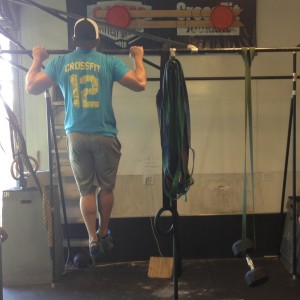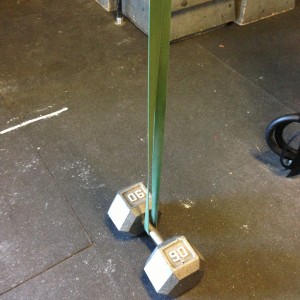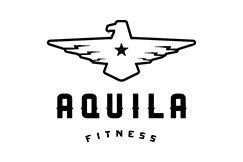In Teams of 2 or 3,
Run 1 Mile Together
50 Tire Flips
600m Sled Drag 180/135
100 Burpees Alternating
*For tire and sled, break up, take turns or work together as needed to finish as fast as possible.
Yesterday’s blog post discussed going hard, motivation, and scaling for intensity. I made mention of how doing pull ups with bands may lower the intensity of a workout. Today I want to explain that a little better how bands effect intensity and give you some ideas about how to scale your pull ups to get the desired effect.
When trying to explain intensity, the bottom line is that intensity is equal to how much work is being done in a given amount of time. In physics we might refer to work in terms of wattage, joules, or horsepower. If you ever took the class you might remember the following equation, Work = (Force x Distance) / Time. How much does it weigh? How far did it move? And how long did it take? If we relate this to a pull up, we are interested in a person’s body weight, their range of motion, and how long a pull up takes. If you weigh more, move farther, or do the pull up faster you are producing greater intensity.
So what about bands and intensity?


To illustrate my point, I used dumbells to figure out approximately how much force the band was producing. I found a dumbell that stretched the band to the same range of motion as my foot does at the top of a pull up, and a dumbell that stretched it to where I’d be at the bottom of a pull up. (on this bar, my foot was on the floor at the bottom of the pull up)
Judging from the dumbells, the band was assisting me by about 90# at the bottom of the range of motion, and by about 55# at the top. The 90# DB is actually teetering just off the floor. For arguments sake, we will take the average and say that the green band assists someone of my height by about 75#. If you were taller, the band would help a bit more because you stretched it farther, and if you were shorter the band would help a bit less.
I weight 200#. Most you you are much lighter. 75# is almost 40% of my body weight, which means that the green band reduced the work done on my pull up by about 40%. If I were doing pull ups in a WOD with a green band, the band would reduce the intensity of my pull ups by about 40%. Feel free do do a proof on this if you don’t believe me. If you weight less than me, the band would reduce your intensity by a larger percentage. So from a conditioning standpoint, by using the band you are effectively turning your pull ups into an active rest station where you are working a skill but not getting good conditioning. Your power output or intensity will drop significantly while the band does the work for you.
So what should you do? Well you need to make yourself better at pull ups so you don’t need assistance during your WODs. Work on them hard a few times a week outside of your WODs until you don’t need bands anymore. If you are strong, but are struggling with pull ups mostly due to excess body weight, then read about Zone and Paleo.
What about pull ups in your WODs? Well, the answer is complicated and will require you to think about the intent of the workout and your personal goals. If the intent of the workout is to get hard conditioning and increase your fitness level, then one answer is to do jumping pull ups. Jumping pull ups require you to do all of the work yourself since there is no band pulling you up. Jumping pull ups have a similar feel to doing burpees. You will not stop because your out of muscular strength, you will stop because your heart is about to explode. You will stop from cardiovascular failure, which is what we want to happen… right before you jump back up to go at it again.
The major downside to jumping pull ups is that they do not build the upper body strength required to get better at pull ups. So if your biggest goal is to get better at pull ups, you should sometimes use a band in your WOD with the intent of getting better at pull ups. It is important to realize that if you are using the band in this way, you are likely getting less conditioning from that portion of the workout. If the pull ups are mixed in with some other movements that are going to get your heart rate up sky high, you can get your conditioning on the other stations and use the banded pull up station as an active rest station, but you better get off that pull up bar and start hitting it hard again.
The other option is to scale the number of pull ups down to a number that you can complete quickly without help. This will keep your output high and you can move on to the next exercise quickly. Pick a number that is easy for the first round or two, but still doable later in the WOD. You cannot afford to be standing on the floor looking up at the bar during your metcons.
If you are someone who is mainly struggling with pull ups because you are overweight, you need to lose weight and using the jumping pull up is probably a more effective approach for helping you do so than the assisted pull up.
If you already have good conditioning, are not overweight, and just lack upper body strength, you may want to actually use the band to help you complete the reps in the WOD. But keep in mind, doing sets of 10 or more is not building strength as much as is is building muscular endurance. Your best bang for your wang on building strength is to perform reps that are hard enough to cause muscular failure in less than 8 reps or so.
The most important part of this equation is to have a actual thought process related to your goals and the intent of the workout. There isn’t a simple right answer to the question whether or not to do banded or jumping pull ups as a scale, but if you are at least carefully thinking about why you are doing one or the other you are more likely to be successful. Realize that bands can significantly lower the intensity of certain WODs, especially those where pull ups are a major part of the total workload. If you are unsure about how to scale your pull ups, or anything else in a WOD, talk to your coach and get some ideas. Proper scaling can get you to your goals much more efficiently.





